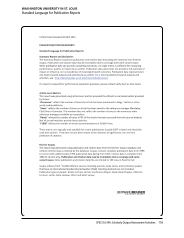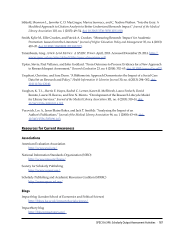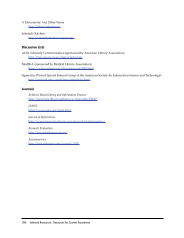50 · Survey Results: Survey Questions and Responses
Plan to explore the potential for collaboration with the university’s research services department.
The library only played a facilitating role in introducing assessment services and resources, beyond the library holdings,
to various campus units.
The provost’s office subscribes to Digital Measures. We are making efforts at working with them, so that we can ingest
citation information (and maybe full-text) into our institutional repository.
There has also been work done independently of the library on assessing academic programs through scholarly output
assessment measurements through our Academic Planning and Institutional Research Office.
This is a growth area for library services. It’s important to be able to show impact of our university’s research for a
variety of reasons, and library staff are well placed to understand how best to do this.
This is a new area and there needs to be more communication and cooperation among the various entities interested
in assessing the scholarship of our institution. The other problem is that direct quantitative assessment (the numbers
game) can create furor and significant push back where the validity of the metrics used, the underlying data, and
interpretation of results is questioned. Librarians tend to come from a perspective of transparency and openness, but
that is not always the perspective of everyone else. Understandably, this is a sensitive area and perhaps not enough
care has been taken to make sure scholars and departments are assured that they will not be nor be judged by a single
“magic” number.
We are in the planning stages of partnering with the provost on scholarly output assessment.
We have had very preliminary conversations about standardizing ORCIDs across campus with the associate provost
for research.
We have no formal arrangements, but the library is part of the conversation at all different levels, e.g., serve as
consultant on specific databases, products.
We would like to work more closely with the graduate school as well as vendors, e.g., ProQuest dissertations dashboard.
We’re seriously considering building the software for a faculty information system in-house rather than purchasing from
a vendor.
Working with partners is key to understanding all of the different parts of the issue and reaching all of the different
relevant groups. For us, our strategic plan and the focus on research outcomes is a driving force.
MARKETING AND PUBLICITY
22. What methods does your library use to promote scholarly output assessment activities and
services? Check all that apply. N=73
Word of mouth 54 74%
LibGuides 48 66%
Library website 44 60%
Blog posts 21 29%
Social media messages 20 27%
Flyers 15 21%
Brochures 12 16%
Other method 34 47%




























































































































































































